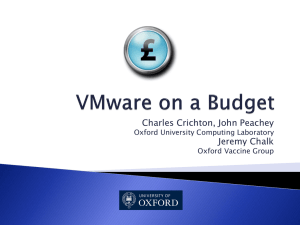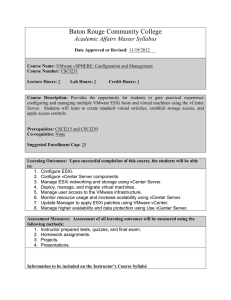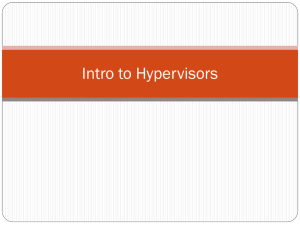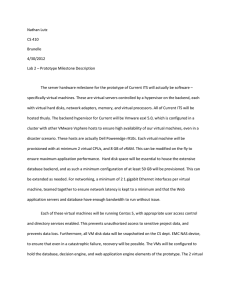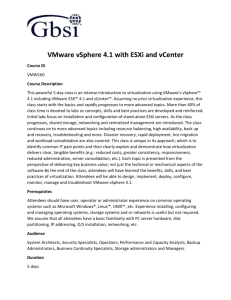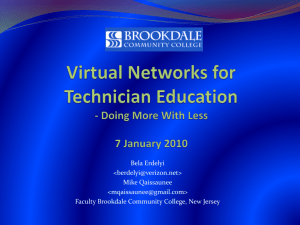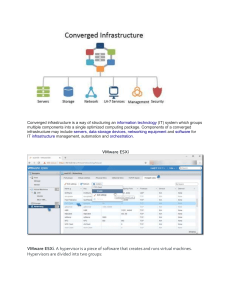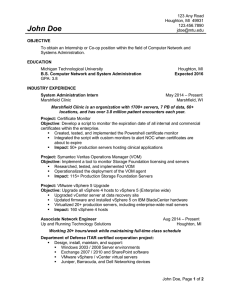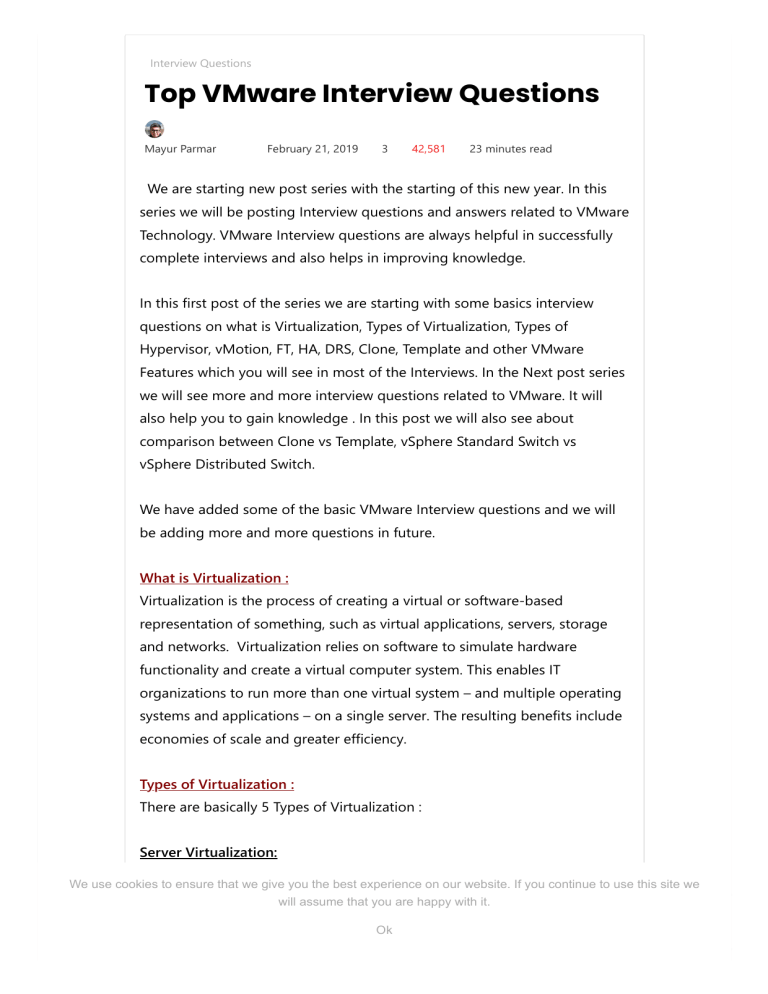
Interview Questions Top VMware Interview Questions Mayur Parmar February 21, 2019 3 42,581 23 minutes read We are starting new post series with the starting of this new year. In this series we will be posting Interview questions and answers related to VMware Technology. VMware Interview questions are always helpful in successfully complete interviews and also helps in improving knowledge. In this first post of the series we are starting with some basics interview questions on what is Virtualization, Types of Virtualization, Types of Hypervisor, vMotion, FT, HA, DRS, Clone, Template and other VMware Features which you will see in most of the Interviews. In the Next post series we will see more and more interview questions related to VMware. It will also help you to gain knowledge . In this post we will also see about comparison between Clone vs Template, vSphere Standard Switch vs vSphere Distributed Switch. We have added some of the basic VMware Interview questions and we will be adding more and more questions in future. What is Virtualization : Virtualization is the process of creating a virtual or software-based representation of something, such as virtual applications, servers, storage and networks. Virtualization relies on software to simulate hardware functionality and create a virtual computer system. This enables IT organizations to run more than one virtual system – and multiple operating systems and applications – on a single server. The resulting benefits include economies of scale and greater efficiency. Types of Virtualization : There are basically 5 Types of Virtualization : Server Virtualization: Server virtualization enables multiple operating systems to run on a single We use cookies to ensure that we give you the best experience on our website. If you continue to use this site we physical server as highly virtual machines. In Server Virtualization will efficient assume that you are happy with it. physical server resources are abstracted logically to create and run virtual Ok Privacy - Terms machines. Examples are VMware vSphere, Microsoft Hyper-V, RedHat KVM etc. Storage Virtualization: Storage Virtualization enables grouping of multiple physicals storage into single logical storage and it will be presented as a single storage to all the servers. It allows you to easily manage storage and maintain consistent performance. Example VMware vSAN. Network Virtualization: Network Virtualization allows you to make a complete software defined networks by decoupling the virtual networks from the underlying network hardware. Main function of Network Virtualization is to remove the dependency multiple of the Physical Network Devices. Examples are VMware NSX. Desktop Virtualization: Desktop Virtualization enables you to deploy multiple desktops on the single or multiple hardware at a single location and desktop is accessed by users from any location using any device. It is also called as Virtual Desktop Infrastructure (VDI). Examples are VMware Horizon View , Citrix Xen Desktop. Application Virtualization Application Virtualization enables you to host an Application on the server and it can be accessed from anywhere with Internet connectivity, where users don’t have to install Application. Examples are VMware ThinApp, Citrix XenApp. What is Hypervisor: Hypervisor, also known as a virtual machine monitor, is a process that creates and runs virtual machines (VMs). A hypervisor allows one physical server to run multiple virtual machines by sharing its physical resources virtually such as CPU, Memory, GPU etc. Hypervisor isolates virtual machines running on a single hardware. Examples are VMware ESXi, Microsoft Windows Server Hyper-V. We use cookies to ensure that we give you the best experience on our website. If you continue to use this site we Types of Hypervisor: will assume that you are happy with it. There are basically 2 types of Hypervisor which are Type 1 and Type 2. Ok Privacy - Terms Type 1 is called as bare metal hypervisor which directly runs on the Physical Server hardware. It is completely independent from operating system. Examples of Type 1 Hypervisors are ESXi, Xen Server, Microsoft Hyper-V. Type 2 is called as Hosted Hypervisor which runs on the Guest Operating system. It is dependent on the Operating system. Examples of Type 2 Hypervisors are VMware Workstation, Oracle Virtual Box. What is HCI : HCI is a Hyper Converged Infrastructure. Hyper-converged infrastructure (HCI) is a software-defined IT infrastructure that virtualizes all of the elements of conventional “hardware-defined” systems. HCI includes virtualized computing (a hypervisor), a virtualized SAN (software-defined storage) and virtualized networking (software-defined networking). All of the components are managed using the software only. In Simple terms HCI includes Server, Storage and Network into a single physical Hardware. What is ESXi : ESXi is an Enterprise class Bare Metal Type 1 Hypervisor developed by VMware for Server Virtualization. ESXi is a small Operating system which is directly installed on the Physical Hardware. By installing ESXi you can create and manage multiple virtual machines on a single Hardware. Latest version of ESXi is 6.7. Different between ESX and ESXi: VMware ESX: ESX is also called as Elastic Sky is a server virtualization by VMware. In ESX VMkernel is a virtualization kernel which is used by the console operating system. Console is Linux based and its main function is to provide management interface and run the management agents. You can also deploy third party agents for management and monitoring of the hardware. ESX is discontinued by VMware long ago. VMware ESXi: ESXi also called as Elastic Sky X Integrated is a server virtualization platform by VMware. ESXi is a very small & most secure operating system We use cookies to ensure that we give you the best experience on our website. If you continue to use this site we architecture. Service console is removed in ESXi and all the activities are will assume that you are happy with it. done by VMkernel itself. ESXi provides DCUI (Direct Console User Interface) Ok Privacy - Terms to manage the ESXi Server. Nowadays you will only find the ESXi Hypervisor running in the VMware Infra. Comparison between ESX vs ESXi: Competence Service Console Troubleshooting is done by Active Directory Authentication Secure syslog Management Network Interface Jumbo Frames Hardware Monitoring Boot from SAN ESX ESXi Service Console is Service Console is Present in ESX. removed in ESXi. Service Console ESXi Shell Supported Supported Disabled Enabled Service Console VMkernel Supported Supported Using 3rd Party Agents in Service Console Using CIM Providers. Supported in ESX Supported in ESXi Same supported on Only Few Updates and Linux Operating Patches because of System small footprint. Scripted Installation Supported Supported vMA Support Available Available Not Supported Supported. Not Supported Supported. Software Updates and Patches Deployment using Auto Deploy Custom Image Creation Using vSphere Web vSphere Web Access Experimental basis Client for complete We use cookies to ensure that we give you the best experience on our website. If you continue to use this site we management. will assume that you are happy with it. Command Line esxcfg Ok esxcli Privacy - Terms Administration using Present to prevent Lock Down Mode Not Present remote login to the host. Fault Tolerance, Use of VMkernel Storage Connectivity, Network vMotion. It is discontinued. Last Latest Version version is ESX 4.1 Fault Tolerance, Storage Connectivity, vMotion, Management Network, iSCSI ESXi 6.7 What is Host & Guest Machine: Host Machine is the Physical Hardware which provides the resources to the guest virtual machines. Host Machine allocates the CPU, Memory and other resources to the Guest Machines running on it. Guest Machine is referred to as virtual machine. Guest machine runs on the Hypervisor in an isolated environment. Guest machines will have their own CPU, Memory and Storage independent. Guest Machine will also have its own operating system inside each Guest. What is VMware Workstation: VMware Workstation is a Type 2 Hypervisor which is installed in Windows or Linux OS. VMware Workstation allows you to create and run virtual machines. It is mostly used for testing of applications and servers by users. It provides the complete isolated environment for virtual machines. It comes with many useful features such as virtual networking,cloning,snapshot etc. Latest version of VMware Workstation is 15 Pro. What is Virtual Machine: We use cookies to ensure that weisgive you the best experience onlike our awebsite. If you continue runs to use this site we A virtual machine a software computer that, physical computer, will assume that you are happy with it. an operating system and applications. The virtual machine is comprised of a set of specification and configurationOk files and is backed by the physical Privacy - Terms resources of a host. Every virtual machine has virtual devices that provide the same functionality as physical hardware and have additional benefits in terms of portability, manageability, and security. What are Virtual Machine Files: When we create virtual machine it creates the multiple files in the back end, you can access and view those files using datastore browser but it is not recommended to change or modify those files. Below are the files of Virtual Machine: Sr No File Usage Description Virtual Machine 1 .vmx Windows.vmx configuration file. It contains all the information about virtual machine. 2 .vmxf Windows.vmxf 3 .nvram Windows.nvram Additional virtual machine configuration file. Virtual Machine BIOS or EFI Configuration file. Virtual disk characteristics 4 .vmdk Windows.vmdk (Descriptor file). It contains information about virtual disk. Virtual Machine data disk 5 -flat.vmdk Windows-flat.vmdk file. It is the file where your data is stored. 6 .vmss Windows.vmss 7 .vswp Windows.vswp 8 .vmsd Windows.vmsd Virtual Machine suspend file. Virtual Machine swap file. Virtual Machine Snapshot database file. We use cookies to ensure that we give you the best experience on our website. If you continue to use this site we 9 .vmsn Virtual will assume that you are happy with it.Machine Snapshot Windows.vmsn Ok state file. Privacy - Terms 10 .log Windows.log Virtual Machine log file. Virtual Machine Old log 11 -#.log Windows-#.log files. Where # represents Number. 12 .vmtx Windows.vmtx Virtual Machine Template. What is VMkernel : VMkernel is a Networking interface between ESXi and Virtual Machine. VMkernel provides Layer 2 and Layer 3 services to the ESXi Host. It is responsible to provide physical resources to the virtual machines such as CPU, Memory, Storage etc. When ESXi is installed one default VMkernel is created for management. You can also create additional VMkernel for below services: 1. Management Traffic 2. vMotion Traffic 3. Fault Tolerance Logging 4. vSphere Replication Traffic 5. vSphere Replication NFC traffic 6. Provisioning Traffic 7. vSAN What is Cluster: Cluster in VMware is logical grouping of multiple ESXi Hosts. Where you can add or remove hosts from the cluster. You can enable features such as HA, DRS on the Cluster. What is VLAN: Virtual LANs (VLANs) enable a single physical LAN segment to be further segmented so that groups of ports are isolated from one another as if they were on physically different segments. You can configure VLANs in ESXi using below 3 Methods: We use cookies to ensure that we give you the best experience on our website. If you continue to use this site we External Switch Tagging (EST): that you are happy with it. will assume With EST, all VLAN tagging of packets is performed on the physical switch. Ok Host network adapters are connected to access ports on the physical switch. Privacy - Terms Port groups that are connected to the virtual switch must have their VLAN ID set to 0. Virtual Switch Tagging (VST): With VST, all VLAN tagging of packets is performed by the virtual switch before leaving the host. Host network adapters must be connected to trunk ports on the physical switch. Port groups that are connected to the virtual switch must have an appropriate VLAN ID specified. Virtual Guest Tagging (VGT): With VGT, all VLAN tagging is performed by the virtual machine. VLAN tags are preserved between the virtual machine networking stack and external switch when frames are passed to and from virtual switches. Physical switch ports are set to trunk port. What is vCenter Server: vCenter Server provides centralized management for the vSphere Infrastructure. It Provides management of ESXi Hosts and Virtual Machines from single console. So you can manage and perform operations on the ESXi and Virtual Machines from using single pane. latest version of vCenter Server is 6.7. What is Platform Service Controller: Platform Service Controller(PSC) is an very important component of vSphere Infra. PSC allows all VMware products within the same environment can share the authentication domain and other services. Services include certificate management, authentication, and licensing. PSC can be deployed Embedded with vCenter Server or as an External Platform Service Controller. What are the Services in Platform Service Controllers: Below are the services in Platform Service Controllers We use cookies to ensure that we give you the best experience on our website. If you continue to use this site we will assume that you are happy with it. Ok Privacy - Terms VMware Appliance Management Service (only in Appliance-based PSC) VMware Appliance Monitoring Service VMware License Service VMware Component Manager VMware Identity Management Service VMware HTTP Reverse Proxy VMware Service Control Agent VMware Security Token Service VMware Common Logging Service VMware Syslog Health Service VMware Authentication Framework VMware Certificate Service VMware Directory Service Types of Deployment supported in vCenter Server: When you deploy vCenter Server you have 2 deployment options available Embedded PSC and External PSC. In Embedded PSC, vCenter will have embedded platform service controller. In case of External PSC, you can deploy vCenter and Platform Service Controller individually. What is the Operating System of vCenter Server Appliance: With the release of vSphere 6.5 and later vCenter Server Appliance uses Photon OS which is based on the Linux. Previous version of VCSA was using the OpenSuse Linux. What is SSO: vCenter Single Sign-On (SSO) is a component of the VMware Cloud Suite. SSO is an authentication service that implements the brokered authentication architectural pattern. SSO is based on identity management technology built by RSA. SSO allows you to access and authenticate to multiple vSphere components from single user only. What is Datastore: Datastore is an logical container backed by the storage LUNs. Datastore is mapped to each ESXi hosts as a storage container. Datastore is used to store virtual machine files, ISO, scripts etc, You can create datastores based on We use cookies to ensure that we give you the best experience on our website. If you continue to use this site we your requirement. Datastore canthat be of or NFS will assume youVMFS are happy withformats. it. What is VVOLs: Ok Privacy - Terms Virtual Volumes (VVols) is an integration and management framework that virtualizes SAN/NAS arrays, enabling a more efficient operational model that is optimized for virtualized environments and centered on the application instead of the infrastructure. VVOLs is an object based storage , which storage virtual machine files as an objects. What is VMFS: VMFS(Virtual Machine File System) is high performance clustered file system specially designed and optimized for virtual machines. VMFS leverages shared storage to allow multiple vSphere Hosts to access the same storage concurrently. VMFS enables virtualization infrastructure services such as VMware DRS, VMware HA, vMotion and Storage vMotion to operate across a cluster of ESXi Hosts. What is VMDK: VMDK is referred to as Virtual Machine Disk. There are basically 2 types of VMDK which are Descriptor and Flat. Descriptor VMDK does not contain any data from virtual machine it stores the configuration and mapping of flat VMDK. Flat VMDK are the original virtual disk files who stores the actual virtual machine data. What Types of Network Storage is supported in vSphere : Below are the Network Storage Types are supported in vSphere: Technology Protocols Transfers Interface Fibre Channel FC/SCSI Block Access/LUN FC HBA · Converged Network Adapter Fibre Channer over Ethernet (Hardware FCoE) FCoE/SCSI Block Access/LUN · NIC with FCoE Support (Software FCoE) iSCSI IP/SCSI Block Access/LUN · iSCSI HBA or iSCSI-enabled NIC (Hardware iSCSI) We use cookies to ensure that we give you the best experience on our website. If you continue to use this site we will assume that you are happy with it. · Ok Network Adapter (Software Privacy - Terms iSCSI) NAS IP/NFS File level Access Network Adapter Disk Types in VMware ? There are basically 3 types of disk types in VMware. 1. Thin Disks: Thin disks are the most used disks in the virtual machine because of it’s dynamic nature. Thin disks allocates the space on the disk on demand. 2. Thick provision lazy zeroed : Thick provision laze zeroed when used it allocates all the space from the datastore to the vm at time of creation only. When the disk is created it is not erased but zeroed out on demand while writing the data from the virtual machine. 3. Thick provision eager zeroed : Thick provision eager zeroed also allocates the whole disk space at the time of creation from the datastore. When this disk is created all the data is zeroed out of the disk. This disk usually takes much longer time as compared to other disks. What is Template: Template is an master copy of the virtual machine. It means using Templates you can create and provision thousands of virtual machines with same specifications. You can convert your virtual machine into Template to create a Template. For Example you can create a VM with all the updates and software installed then you can convert VM into Template so you can deploy VMs from that template whenever you required. What is Clone: Clone is a exact copy of virtual machine. When you clone a virtual machine, you create a copy of the entire virtual machine, including its settings, any configured virtual devices, installed software, and other contents of the virtual machine’s disks. For Example when you want to deploy same copy of virtual machine, you can clone that virtual machine. We use cookies to ensure that we give you the best experience on our website. If you continue to use this site we Comparison between Clone and Template: will assume that you are happy with it. Clone Template Ok Privacy - Terms Clone is a Copy of VM Template is Master Image or Base Image of VM. Clones are used when you want test and create exact same copy of VM. Templates are used when you want to deploy multiple VM’s with same configuration. Cloned VM can be Powered On. Template Can’t be Powered On. You can not Convert Clone to VM You can convert Template to VM from which it was taken. and vice versa. Clone can be edited Template cannot be edited. You can Power on Cloned VM You cannot Power on Template. You can Clone VM when VM is Powered on. You can not convert VM to Template when VM is Powered on. You can perform clone to template. Clone is used in Test and Template is used mostly in Development Environments. Production Environments. Does not recommended for Large Recommended for Large Deployment of VMs. Deployment of VMs. What is Snapshot: Snapshot is most useful feature when you want to preserve the entire state of the virtual machine. When you take snapshot current state of the virtual machine is preserved and you can revert to the previous state whenever you required. It is recommended to not to store snapshots for more then 72hrs. What is VMware Tools: VMware Tools is a suite of utilities that you install in the operating system of a virtual machine. VMware Tools enhances the performance of a virtual machine. You can install VMware Tools on Windows as well as Linux Operating Systems. VMware Tools has many benefits such as Improved mouse performance, Copy and paste text & files, synchronization of Clock in VM, Faster graphics performance and many more. We use cookies to ensure that we give you the best experience on our website. If you continue to use this site we will assume that you are happy with it. What is Hardware Version: Ok Privacy - Terms The hardware version of a virtual machine reflects the virtual machine’s supported virtual hardware features. These features correspond to the physical hardware available on the ESXi host on which you create the virtual machine. Virtual hardware features include BIOS and EFI, available virtual PCI slots, maximum number of CPUs, maximum memory configuration, and other characteristics typical to hardware. You can easily upgrade Hardware version of Virtual Machine but it requires virtual machine to be powered Off. Memory Management Techniques in VMware: ESXi uses 4 types of Memory management Techniques to reclaim memory when psychical memory is not available. Below are 4 types : Transparent Page Sharing (TPS): TPS is used when multiple virtual machines are using the same operating system so at that time ESXi will check for identical memory pages and it will keep single copy of identical pages by removing redundant pages. This technique will help ESXi to reclaim memory easily. It is enabled by default. Memory Ballooning: Ballooning is a dynamic memory reclamation technique used when ESXi is running out of memory and it uses balloon driver to reclaim memory from VMs. Balloon driver is included in the VMware Tools which is installed in VM. Memory Compression: When the Ballooning doesn’t reclaim memory then ESXi uses Memory Compression. It compresses and stores memory in a cache in the host’s main memory. Memory compression occurs when the page’s compression ratio is greater than 50%. It is enabled by default. Hypervisor based memory swapping: When the TPS, Ballooning and Memory compression doesn’t work ESXi uses Memory Swapping in which ESXi swaps guest VMs memory to the swap file which makes physical memory available for use. We use cookies to ensure that we give you the best experience on our website. If you continue to use this site we What is Standard Switch: will assume that you are happy with it. A vSphere Standard Switch is very similar to a physical Ethernet switch. You Ok use standard switches to provide network connectivity to hosts and virtual Privacy - Terms machines. A standard switch can bridge traffic internally between virtual machines in the same VLAN and link to external networks. To provide network connectivity to hosts and virtual machines, you connect the physical NICs of the hosts to uplink ports on the standard switch. What is Distributed Switch: A vSphere distributed switch functions as a single switch across all associated hosts. This enables you to set network configurations that span across all member hosts, and allows virtual machines to maintain consistent network configuration as they migrate across multiple hosts. In Standard Switch you need to create Port Groups on each host but in case of Distributed Switch you only have to created port groups once and it will be applied to all Hosts. What is Traffic Shaping: ESXi allows you to shape (Limit) the incoming and outgoing traffic on Port Groups. A traffic shaping policy is defined by three characteristics: average bandwidth, peak bandwidth, and burst size. Standard switch only supports the Outbound traffic shaping. What is Port Group: Port Groups aggregates multiple ports of virtual machines. Each port group is identified by a network label, which is unique to the current host. Network labels are used to make virtual machine configuration portable across hosts. You can create either VMkernel port group or VM port group based on requirements. You can set VLAN IDs on Port Groups. Network Adapter Types in VMware: When we add Network Adapter to the VM, we have option to choose from multiple network adapters for better performance. So below are the Network Adapter Types Available in VMware: E1000: It is an Emulated version of the Intel 82545EM Gigabit Ethernet NIC, with drivers available in most newer guest operating systems, including Windows XP and later and Linux versions 2.4.19 and later. E1000E: We use cookies to ensure that we give you the best experience on our website. If you continue to use this site we It is an Emulated version of the Intel 82574 Gigabit Ethernet NIC. E1000E is will assume that you are happy with it. the default adapter for Windows 8 and Windows Server 2012. Ok Privacy - Terms VMXNET: It is Optimized for performance in a virtual machine and has no physical counterpart. Because operating system vendors do not provide built-in drivers for this card, you must install VMware Tools to have a driver for the VMXNET network adapter available. If VMware Tools is not installed in Guest Operating system this adapter will not be visible. VMXNET 2 (Enhanced): It is Based on the VMXNET adapter but provides high-performance features commonly used on modern networks, such as jumbo frames and hardware offloads. VMXNET 2 (Enhanced) is available only for some guest operating systems on ESX/ESXi 3.5 and later. VMXNET 3: A paravirtualized NIC designed for performance. VMXNET 3 offers all the features available in VMXNET 2 and adds several new features, such as multiqueue support (also known as Receive Side Scaling in Windows), IPv6 offloads, and MSI/MSI-X interrupt delivery. VMXNET 3 is not related to VMXNET or VMXNET 2. SR-IOV passthrough: It is Representation of a virtual function (VF) on a physical NIC with SR-IOV support. The virtual machine and the physical adapter exchange data without using the VMkernel as an intermediary. This adapter type is suitable for virtual machines where latency might cause failure or that require more CPU resources. SR-IOV passthrough is available in ESXi 6.0 and later for guest operating systems Red Hat Enterprise Linux 6 and later, and Windows Server 2008 R2 with SP2. What are Security Policies available in Standard and Distributed Switch: Below are 3 Security Policies available in vSphere Standard as well as Distributed Switch: Promiscuous Mode: It is used mostly when you want to Capture or Sniff all the packets coming on the same port group. There are 2 options available Accept and Reject. When it is set to Accept then you can monitor or capture all the network packets on the vSphere standard switch that are allowed We use cookies to ensure that we give you the best experience on our website. If you continue to use this site we under the VLAN policy for the port group that the adapter is connected to, will assume that you are happy with it. but when it is set to Reject there no impact on the packets sent or received. Ok Privacy - Terms MAC Address Changes: It works on the MAC Address of the Virtual Machines. There are 2 options available Accept and Reject. If you set it to Accept then if the VM’s MAC address is changed from the original MAC Address assigned VM will able to send and receive network packets , But when it is set to Reject then If the VM’s MAC Address is changed from the original MAC Address then VM will not able to send or receive network packets. Forged Transmits: It also works same as MAC Address changes in which MAC Address of the VM is Compared by ESXi with the Source MAC Address. There are 2 options available Accept and Reject. When it is set to Accept No filtering is performed and all outbound frames are passed, but when it is set to Reject Any outbound frame with a source MAC address that is different from the one currently set on the adapter are dropped. What is vMotion: vMotion Allows you to lively migrate virtual machines from one physical ESXi host to another ESXi host without downtime. In vMotion only virtual machine will be migrated from one host to another storage stays at the same place. vMotion is most used feature in VMware vSphere. This capability is possible across vSwitches, Clusters, and even Clouds (depending of the vSphere edition that you have). It is also called as live migration. What is Storage vMotion: Storage vMotion allows you to lively migrate virtual machine disk from one datastore to another. It means that you can easily migrate your virtual machine from one storage to other without downtime. By Storage vMotion, you can transform virtual disks from Thick-Provisioned Lazy Zeroed or Thick-Provisioned Eager Zeroed to Thin-Provisioned or the reverse. What is DRS: DRS is also called as Distributed Resource Scheduler. DRS works on the cluster level. DRS is most useful feature when you have heavy workloads. DRS will continuously monitor the load on the ESXi hosts and if the load increases then it will migrate VMs from one host to another to balance the load on the cluster. There is 3 types of modes available in DRS : Fully We use cookies to ensure that we give you the best experience on our website. If you continue to use this site we Automated, Partially Automated and Manual. will assume that you are happy with it. Ok Privacy - Terms What is SDRS : SDRS is called as Storage DRS. SDRS works on the datastore cluster where multiple datastores are added into single cluster. Storage DRS allows you to manage the aggregated resources of a datastore cluster. When Storage DRS is enabled, it provides recommendations for virtual machine disk placement and migration to balance space and I/O resources across the datastores in the datastore cluster. What is High Availability: High Availability is referred as HA in VMware. HA works on the Cluster level. VMware HA provides high availability for virtual machines by pooling them and the hosts they reside on into a cluster. Hosts in the cluster are monitored and in the event of a failure, the virtual machines on a failed host are restarted on alternate hosts. What is Fault Tolerance: Fault Tolerance is referred as FT in VMware. FT works on the VM level. VMware Fault Tolerance provides continuous availability for virtual machines by creating and maintaining a Secondary VM that is identical to, and continuously available to replace, the Primary VM in the event of a failover situation. You can enable Fault Tolerance for most mission critical virtual machines What is EVC: EVC is also called as Enhanced vMotion Compatibility. EVC is used when you have multiple CPU family hosts in the same cluster. EVC feature to help ensure vMotion compatibility for the hosts in a cluster. EVC ensures that all hosts in a cluster present the same CPU feature set to virtual machines, even if the actual CPUs on the hosts differ. Using EVC prevents migrations with vMotion from failing because of incompatible CPUs. What is VCHA: VCHA is the new feature announced in vSphere 6.5. VCHA is referred as vCenter High Availability. VCHA provides high availability for the vCenter Server by creating secondary copy of the vCenter Server. So in case of your primary vCenter fails, secondary vCenter will take over it and you have your vCenter Server running. We use cookies to ensure that we give you the best experience on our website. If you continue to use this site we will assume that you are happy with it. What is Resource Pool: Ok Resource pools allow you to delegate control over resources of a host which Privacy - Terms are CPU and Memory. You can create Resource Pool and assign amount of resources to the virtual machines inside resource pool. A resource pool can contain child resource pools, virtual machines, or both. You can create multiple Resource Pools based on your requirement. What is vApp: A vApp is a logical container, like a resource pools and can contain one or more virtual machines. In addition, a vApp also shares some functionality with virtual machines. A vApp can power on and power off, and can also be cloned. You can even export vApp. What is Host Profiles: Host Profile allows you to create and maintain consistent configurations among ESXi Hosts. You can create Host Profile from on Host and attach it to other host to maintain same configuration and make them compliant. It helps you to avoid the error and misconfiguration in larger environments. What is Hot Add: Hot Add is more useful feature where you can add or increase the CPU and Memory of the Virtual Machine while it is running. First you have to enable Hot Add CPU and Memory for the Virtual Machine when you create Virtual Machine. What is VUM: VUM is also called as VMware Update Manager. VUM is used for Upgrading and Patching of ESXi Hosts. With VUM you can also upgrade VMware Tools and virtual appliances. What is vCenter Converter: vCenter Converter is used to convert Physical Servers into virtual machines. By using vCenter Converter you can easily convert your Physical Server into Virtual Machine without much hassle of creating vm and copying data. Conversion Process is called as P2V. What is Content Library in VMware : Content Library is the container you create to store different objects such as Template, ISO, Config Files, Scripts etc. It allows you to Sharing templates and files across multiple vCenter Server instances in the same or different We use cookies to ensure that we give you the best experience on our website. If you continue to use this site we locations results in consistency, compliance, efficiency, and automation in will assume that you are happy with it. deploying workloads at scale. Ok Privacy - Terms What Two Types of Content Library available in VMware : There are basically two types of content library comes local and subscribed. Local Content Library: You use a local library to store items in a single vCenter Server instance. You can publish the local library so that users from other vCenter Server systems can subscribe to it. When you publish a content library externally, you can configure a password for authentication. Subscribed Content Library: You subscribe to a published library by creating a subscribed library. You can create the subscribed library in the same vCenter Server instance where the published library is, or in a different vCenter Server system. In the Create Library wizard you have the option to download all the contents of the published library immediately after the subscribed library is created, or to download only metadata for the items from the published library and to later download the full content of only the items you intend to use. What is Cold Migration : Cold Migrations is when you migrate powered off or suspended virtual machines. To perform a cold migration, you can move virtual machines manually or set up a scheduled task. What is Hot Migration: Hot Migrations is when you migrate running powered on virtual machines. vMotion is also referred to as “live migration” or “hot migration.” How vSphere Licensing Works: vSphere is licensed on a per-processor basis. Each physical processor (CPU) in a server needs to have at least one processor license key assigned to be able to run vSphere. There are No Limits on Physical Resources and Number of Virtual Machines. Which License editions are available in vSphere 6.7: Below are the editions available in vSphere 6.7: vSphere Standard vSphere Enterprise Plus We use cookies to ensure that we give you the best experience on our website. If you continue to use this site we will assume that you are happy with it. vSphere with Operations Manager Enterprise Plus vSphere Platinum Ok Privacy - Terms You also have option for Smaller Environment : vSphere Essentials Kit vSphere Essentials Plus kit You also have option for Remote Office and Branch Offices: vSphere Remote Office Branch Office Standard vSphere Remote Office Branch Office Advanced Which are Editions available in vCenter Server: vCenter Server comes in below 3 editions: vCenter Server For Essentials (For Essential Kits with up to 3 ESXi Hosts supported) vCenter Server Foundation (Up to 4 ESXi Hosts supported.) vCenter Server Standard (Unlimited Number of ESXi Hosts supported.) What is vSphere Replication: VMware vSphere Replication is a hypervisor-based, asynchronous replication solution for vSphere virtual machines.By using vSphere Replication you can Replicate virtual machines from one site to another. What is SRM: SRM is referred as Site Recovery Manager. SRM is a business continuity and disaster recovery solution that helps you to plan, test, and run the recovery of virtual machines between a protected vCenter Server site and a recovery vCenter Server site. You can configure SRM with vSphere Replication or with Array Based Replication. What is VMware NSX: NSX is an Network Virtualization by VMware which provides complete virtualization of Networking components in datacenter using software. NSX Data Center provides a complete set of logical networking elements and services, including logical switching, routing, firewalling, load balancing, VPN, quality of service (QoS), and monitoring. These services are provisioned in virtual networks through any cloud management platform We use cookies to ensure that we give you the best experience on our website. If you continue to use this site we leveraging the NSX Data Center APIs. Virtual networks will assume that you are happy with it.are deployed nondisruptively over any existing networking hardware. NSX is main Ok component of Software Defined Data Center (SDDC). Privacy - Terms What are Key Features of VMware NSX: Below are the Key Features of NSX: Switching Routing Distributed Firwalling Load Balancing VPN NSX Gateway Multi Site Networking What are the ways of Installing ESXi: Interactive ESXi installation Scripted ESXi installation Auto Deploy ESXi installation Customizing installations with ESXi Image Builder CLI and Many More. We have selected this interview questions based on the data we have,We will also updating this questions from time to time. If you have any questions or if you want to share any questions you can post it in comments section we will add it in this post. Checkout part 2 of our VMware Interview Questions : VMware Interview Questions Part 2 That’s it for Today Friends. I Hope you liked reading this post & If you find anything more to be added or removed feel free to write it in our comments. If you find it useful You are Feel free to share this on social media to help others & spread knowledge. If you have any query on any thing you are free to write it in our comments section & we will make sure to provide you the better solution as soon as We use cookies to ensure that we give you the best experience on our website. If you continue to use this site we possible. will assume that you are happy with it. Ok Privacy - Terms Join Our LinkedIn Group to get Updates & Discussions : Mastering VMware. Checkout our Facebook Group for discussions & more. You can also Like & Share our Facebook Page for Latest Updates. Information Source: VMware Docs, VMware Portal. Please give your Review on above Post: Your Review is valuable to us for improvement. Thank you for review. User Rating: 4.23 ( 37 votes) #VMware Interview Questions 3 Comments We use cookies to ensure that we give you the best experience on our website. If you continue to use this site we will assume that you are happy with it. Ok Privacy - Terms Samrat Sengupta September 12, 2019 at 2:31 pm Hi Mayur, I appreciate the effort taken and like to congratulate you on the above set of questions. Still waiting for the next Set though. Could you include some questions on PSC, HA, DRS and if possible on ESxi logs to be used for Troubleshooting. Thanks and regards, Sam Reply Mayur Parmar September 12, 2019 at 7:35 pm Hi Samrat, Thanks for your valuable opinion. Yes will try to do on that as well. Reply Rakesh Pandey September 8, 2020 at 11:24 am Thanks for notes and Interview questions. Reply We use cookies to ensure that we give you the best experience on our website. If you continue to use this site we will assume that you are happy with it. Ok Privacy - Terms
